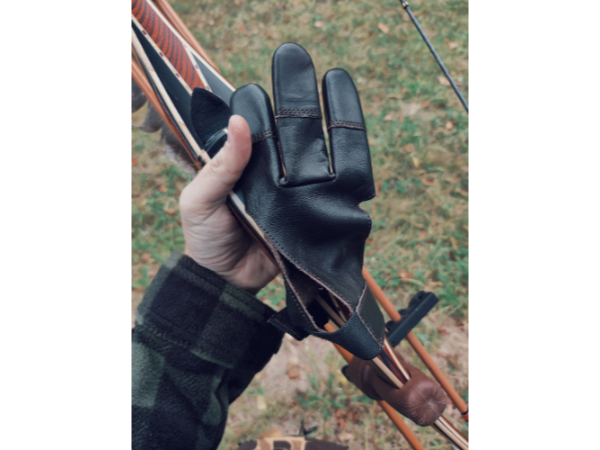There are several different types of clickers. Some attach to a bow’s riser and slide along the arrow; others attach to a bow’s limb and connect to the bowstring by utilizing a short chain and string. Most archers know it is best to replace the standard clicker chain with string to avoid chipping the finish on the bow. However, using one continuous string to connect the clicker to the bowstring requires disconnecting from the bowstring to adjust brace height.
My solution to this problem is to use two strings connected together with a slip knot. A short string is attached to the clicker and replaces the chain; a longer string is attached to the bowstring. The two loose ends are then joined together with a slip knot. Such a combination not only eliminates the chain, it allows adjusting brace height without disconnecting from the bowstring by simply loosening the slip knot.
First, carefully remove the clicker blade from the clicker; then remove the chain from the blade. Next, push a string that is approximately three or four inches in length, through the hole in the clicker blade where the chain was; the fit should be tight. Tie a large enough knot in the end of the string so that it will not pull back through the hole. The knot should not be too large as it may interfere with the clicker blade returning to a flat position. If that happens, insert a small rivet through the blade hole and then push the string into the rivet and crimp it down onto the string. If the string tends to twist in the rivet, use a little super glue where the string and rivet meet. Reassemble the blade to the clicker.
Next, attach one end of the longer string to the bowstring and tie a slip knot in the other end, leaving the loop open. Then, tie a large knot in the loose end of the string attached to the clicker and insert it through the loop (see photo). Tighten the loop by pulling the loose end of the knot. When the loop is tight, tie a large knot around the loose end (see photo) to prevent it from pulling through and untying when you begin to draw your bow.
When you need to adjust your brace height, simply loosen the slip knot and remove the short string attached to the clicker.







great tip!! thank you!!
So, I was always plagued with the chain breaking. You have a good idea here and I have made some other modifications. I don’t think I would remove the short section of the string though to adjust the brace height. I would adjust the long string attached to the bow string. I could either add a longer piece for length or pull the string through for a shorter draw, but that would only be after I was totally convinced I had to after the initial draw check was made. Great idea!!!
Great suggestions…Thank you. I have one question…I would like to replace the Philips screw (holds the clicker assembly in place) with an Allen screw…what size is it, and where can I find one? I went to the local Menard’s store and they didn’t have one the correct length. Any ideas?
Hi Patrick. Here’s Philip’s reply to your question:
I forgot to mention that in my description but I always replace the screw with an Allen head screw. We have a Lowe’s Home and Garden store here where I live and that’s where I get mine. I use a Stainless steel Allen head screw size 6-32. The length is 1\4 inch. I usually use a little bit of Locktite thread lock on mine. (The kind that can be broken loose if you need to.) Also the screw will be about 1\16 th inch to long. To keep it from working thru the double sided tape and and scratching my bow limb, I file the screw flat after putting the clicker back together. I hope this helps. Philip
Mr. Dumm I think you missed something in the tip. You loosen the slip knot on the long string and remove it from the short string to make the adjustment to your brace height then put the long string back on and cinch it down.
Thank you Robin and Mr. Cox for the great info!
I think I’d try pruski hitch to adjust length
Very smart!
Thank you for the tip. I have played around with a clicker just a little, and I do like the end results better with your solution than the “fix” I came up with.
What I did was quick and easy but not aesthetically pleasing. I took a piece of thin tubing the length of the chain with a friction fit diameter. To make adjustments I slide it up on to the string then back over the full chain length when finished.
This works best when you can keep the “tag end” of your chain to a minimum.